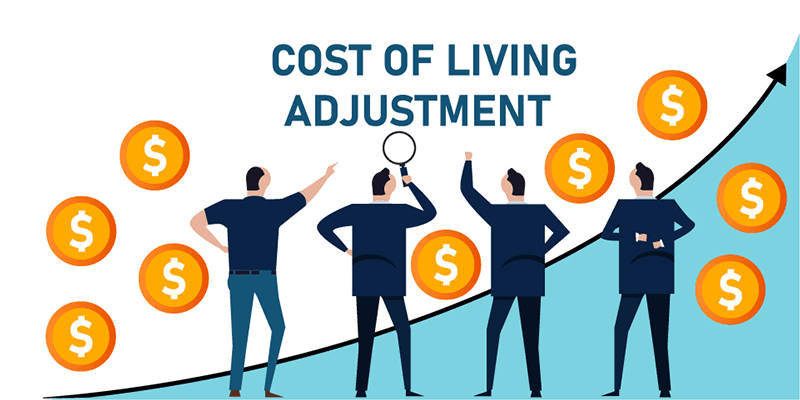Mass Retirees at the Center of Reforms
During the January meeting of the Special COLA Commission, Mass Retirees President Frank Valeri, who sits on the Commission, made a presentation on the history of the COLA (Costof- Living Adjustment). The choice of Valeri to make this presentation was a natural fit, especially when one looks closely at that history and the predominant role played by the Association on this issue throughout the decades.
Over the past 54 years, Mass Retirees has been at the center of every major COLA reform. “While he served as president (1968-2013), Association founder Ralph White always emphasized with us (the staff) that the COLA was the genesis upon which the organization was built,” recalls Counsel Bill Rehrey who worked with White over most of that time. “As he saw it, this ‘bread and butter’ issue continued to be the centerpiece, energizing and enabling the Association to grow in strength.”
We need to look back some 54 years ago to 1971. That’s when Mass Retirees succeeded in enacting Chapter 1011 that created what we call the COLA Base, the maximum pension on which the COLA is applied. Before then, the COLA was very limited, being paid only to those with pensions below $6,000 while those over $6,000 received nothing.
Chapter 1011 significantly restructured the law so that all retirees would begin to receive a COLA on the first $6,000 of their pension. This became the law’s fundamental principle of a maximum pension amount or Base upon which a COLA would be paid to all eligible retirees.
Another major change in the COLA law, also initiated by Mass Retirees, was the 1975 law that made COLAs a permanent part of a retiree’s pension. Prior to this change, the COLA was nothing more than a 1-time bonus payment sometimes referred to as a “13th check”. Ed Note: In most other states, the COLA continues to be treated as a bonus payment – if any COLA is paid at all.
Following the passage of the voter approved Prop. 2 ½ law in 1981, and at Mass Retirees urging, the state took on the role of approving and funding COLAs for all state, teacher as well as local retirees and survivors. This responsibility continued until 1997.
HIGHLIGHTING MORE RECENT DEVELOPMENTS
That’s when Mass Retirees succeeded in enacting Chapter 17, Acts of 1997, the landmark COLA Reform Law that returned responsibility for local COLAs to local retirement systems while increasing the COLA Base to $12,000. Because this law was local option, the Association worked tirelessly to have Chapter 17 adopted locally.
Our efforts paid off with the law being implemented by all systems. And, over the past 26 years, COLAs have been paid, with very few exceptions, by the state, teachers’ and all 102 local retirement boards.
During the 2009-2010 legislative session, the Association achieved another milestone with the enactment of our initiative (Chapter 188, Acts of 2010) that allowed local retirement systems, with the approval of their local legislative body, to increase the maximum $12,000 COLA Base to a higher amount, in $1,000 increments – without any ceiling. And, a year later (2011) we succeeded in increasing the State/ Teachers’ maximum Base from $12,000 to $13,000.
With Chapter 188, we’ve experienced an increase in local COLA Bases ranging from $13,000 to a high of $30,000 – with the local average now just about $16,000. In fact, 100 of the 102 local retirement systems have increased their COLA Bases. Ed Note: The Voice’s next (October) issue will include a complete rundown of the COLA Bases for all retirement systems.
Since Chapter 17’s enactment, the state, teachers and local retirement systems, with very few exceptions, have been paying a COLA by applying 3% to the Base amount. That said, Mass Retirees achieved one very significant increase from the traditional 3%.
In 2022 the Association successfully included in the FY23 State Budget (Chapter 126, Acts of 2022) a provision that established a 5% COLA for state and teacher retirees who were eligible for a COLA on July 1, 2022. We did this primarily to provide financial help to retirees impacted by the inflationary impact of the pandemic.
We didn’t stop there and worked to have a local option law (Chapter 269, Acts of 2022) passed that allowed local retirement systems to adopt a 5% COLA for Fiscal Year 2023. However, Chapter 269’s passage was just the crucial beginning toward final adoption of the increase since Chapter 269 established a somewhat cumbersome approval process, particularly for regional and county retirement systems.
Consequently, a great deal of effort by many went into having the 5% implemented locally. But, as we reported back then in issues of The Voice, all the hard work paid off and eligible local retirees also received a 5% COLA for FY23. This increase to 5% marked the first such increase since 1992.
That brings us current to the Special COLA Commission that we proposed and had included in the FY25 State Budget (Chapter 140). We envision this Commission to be a springboard for more COLA milestones in the future.



